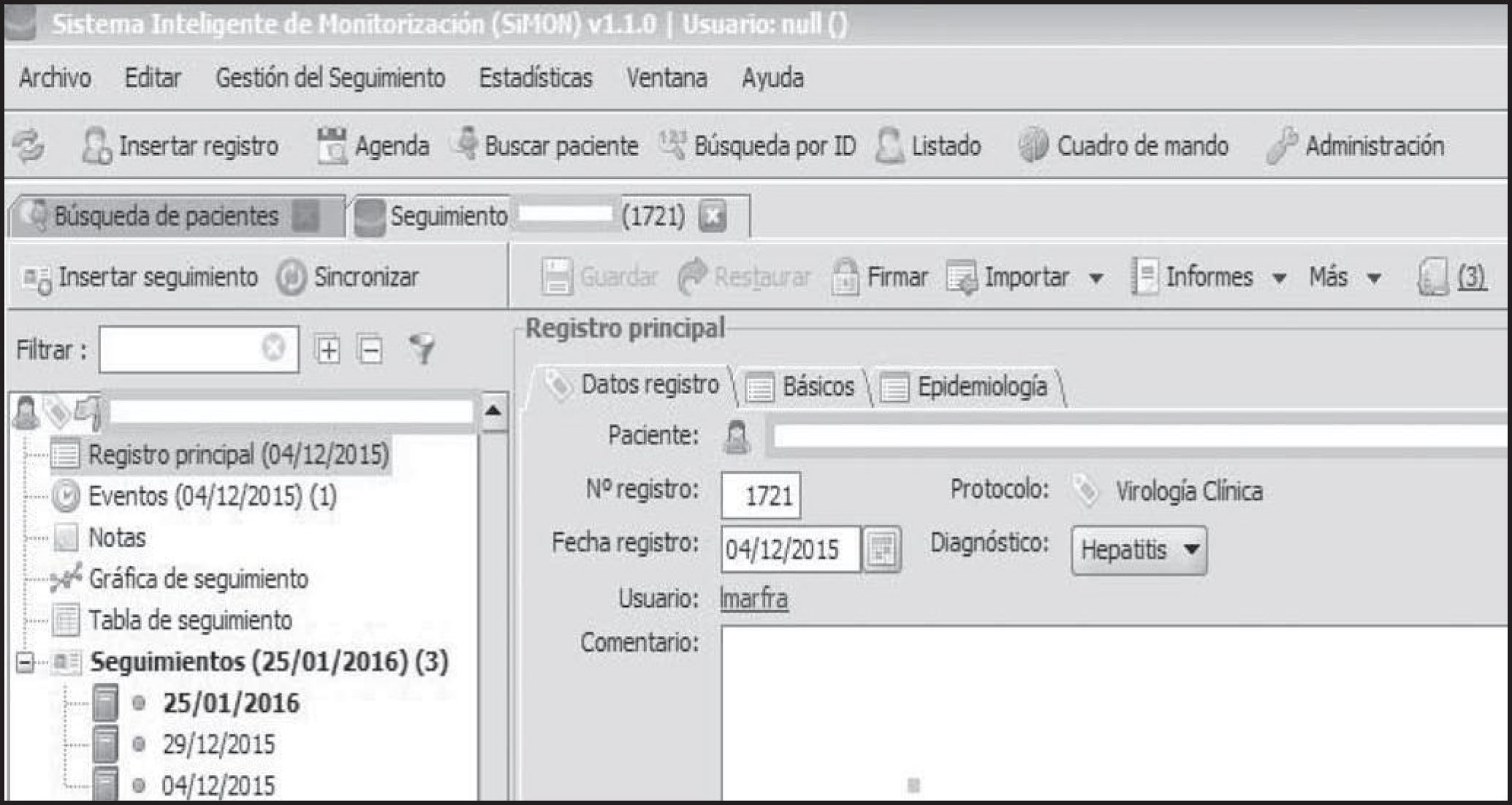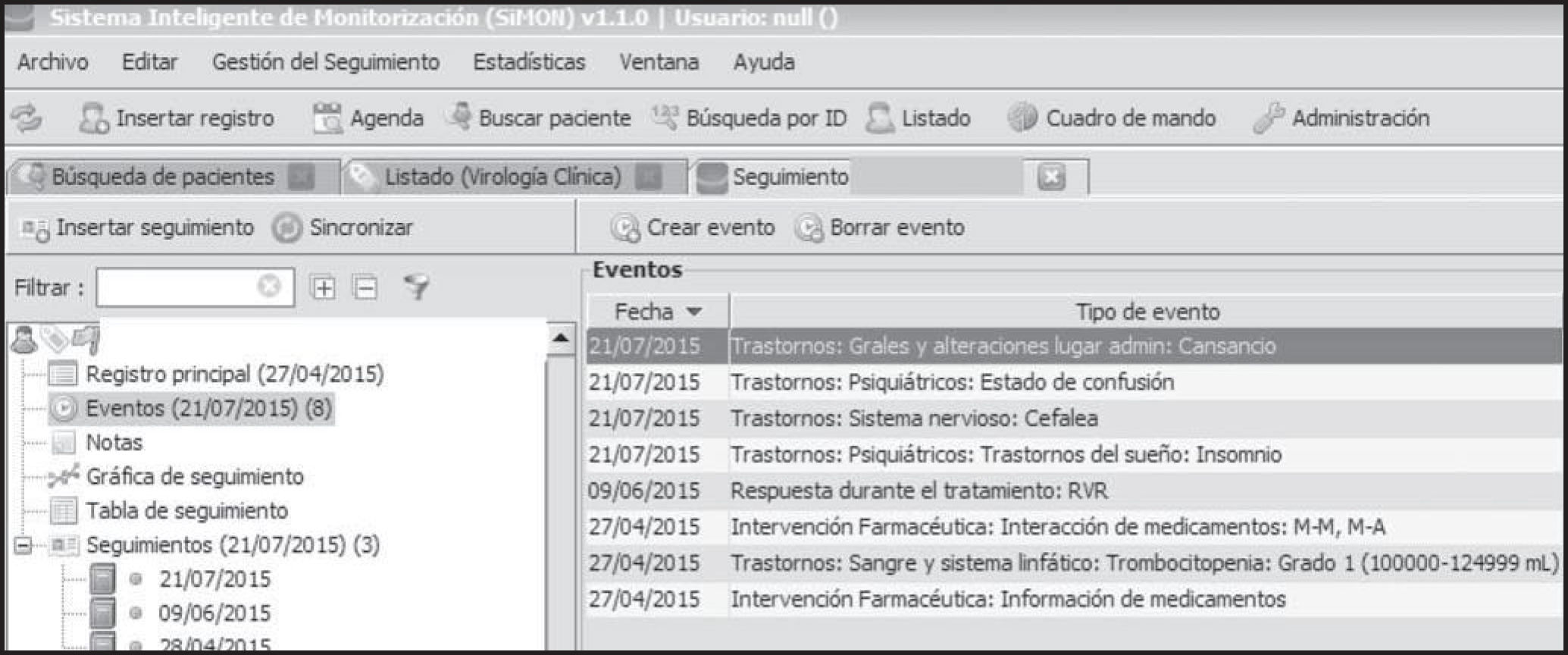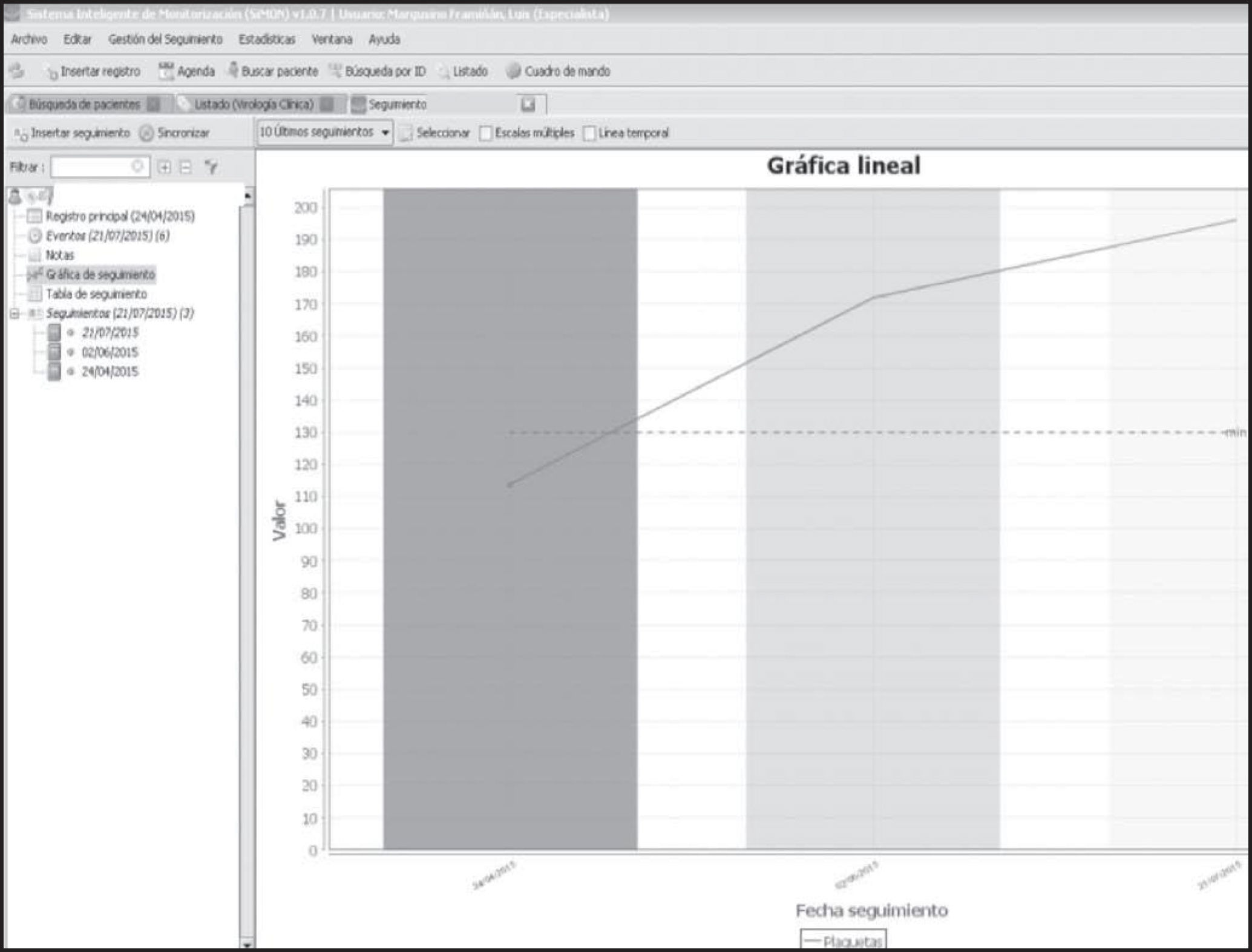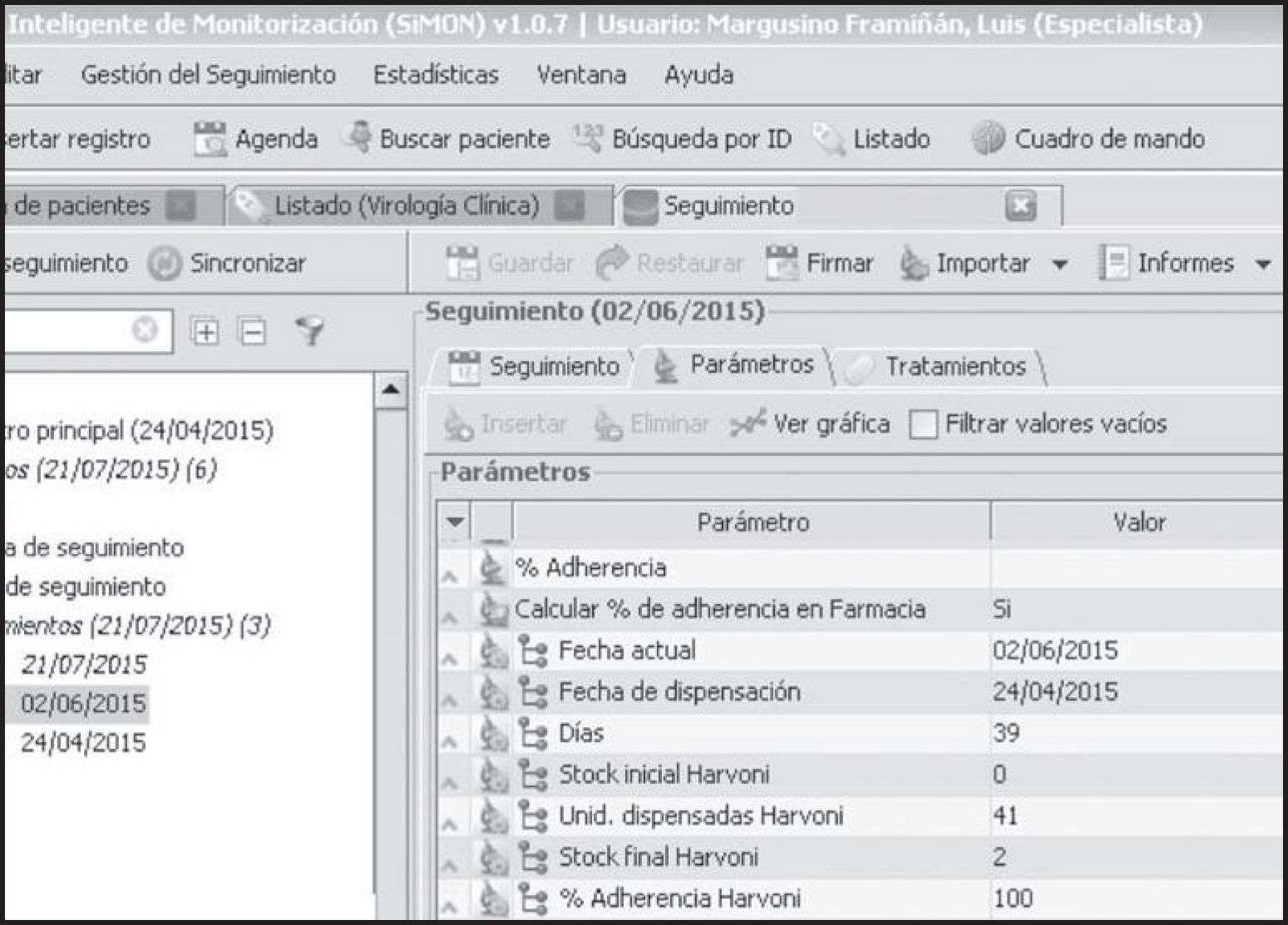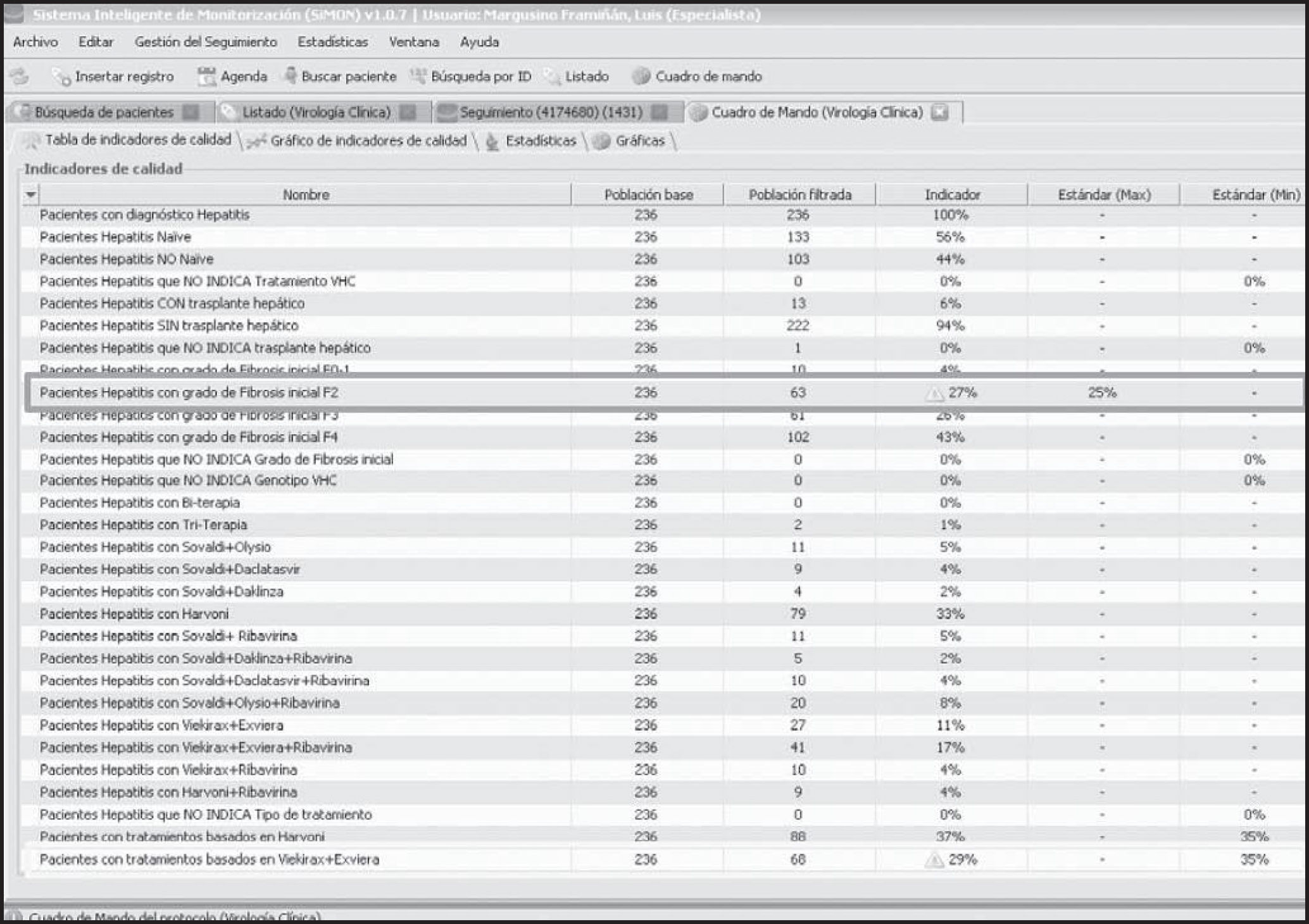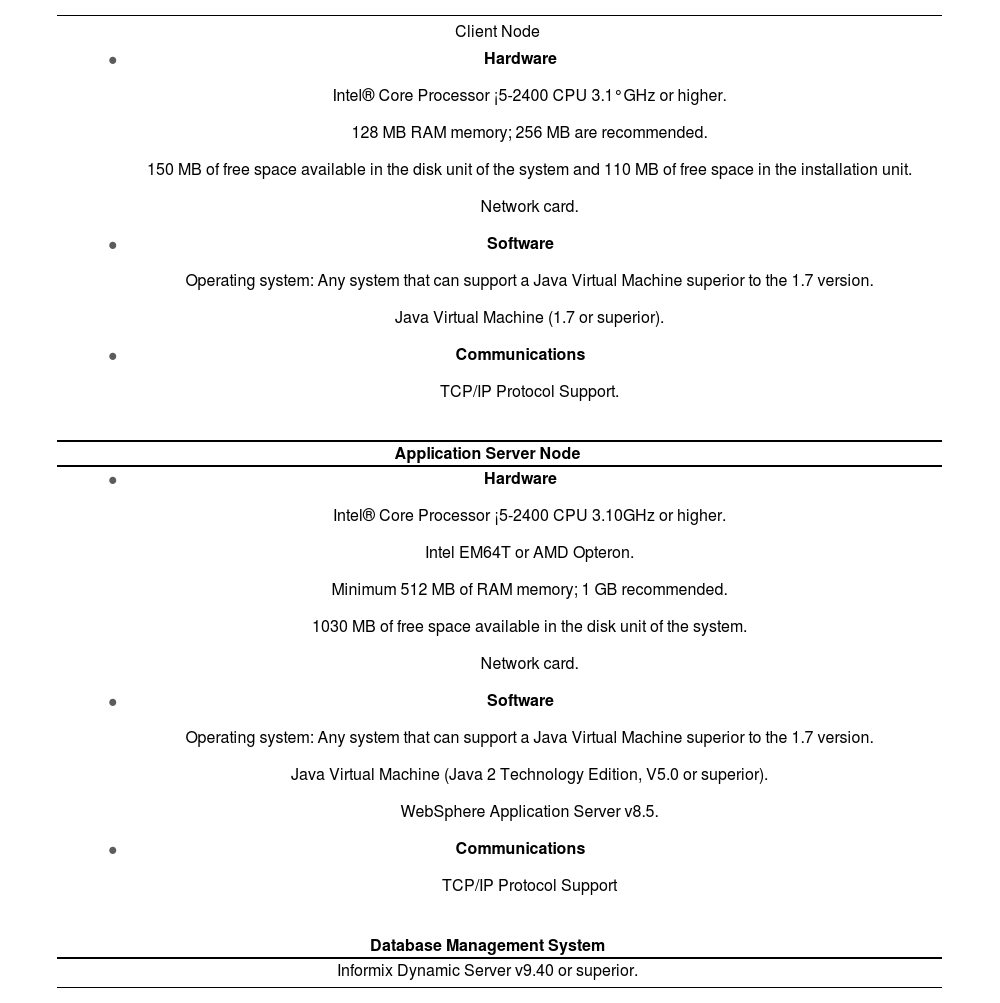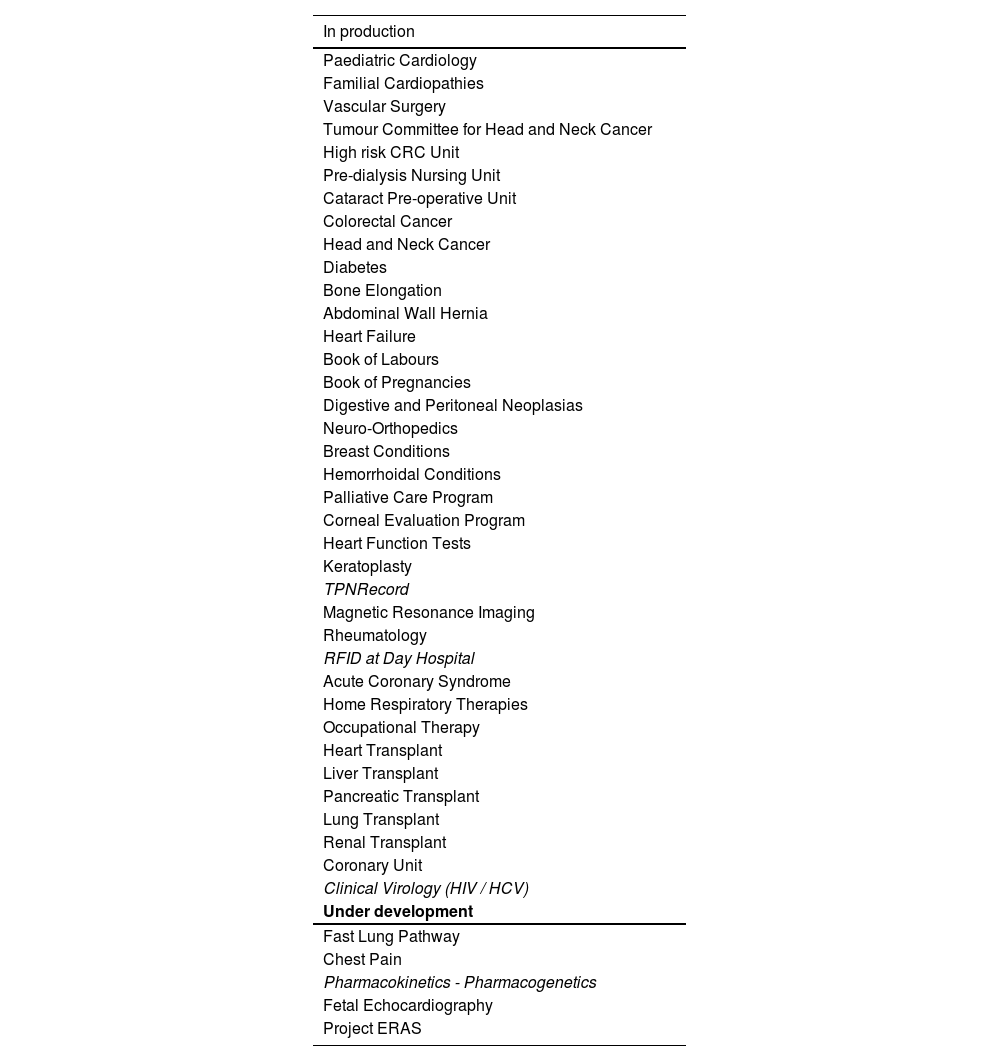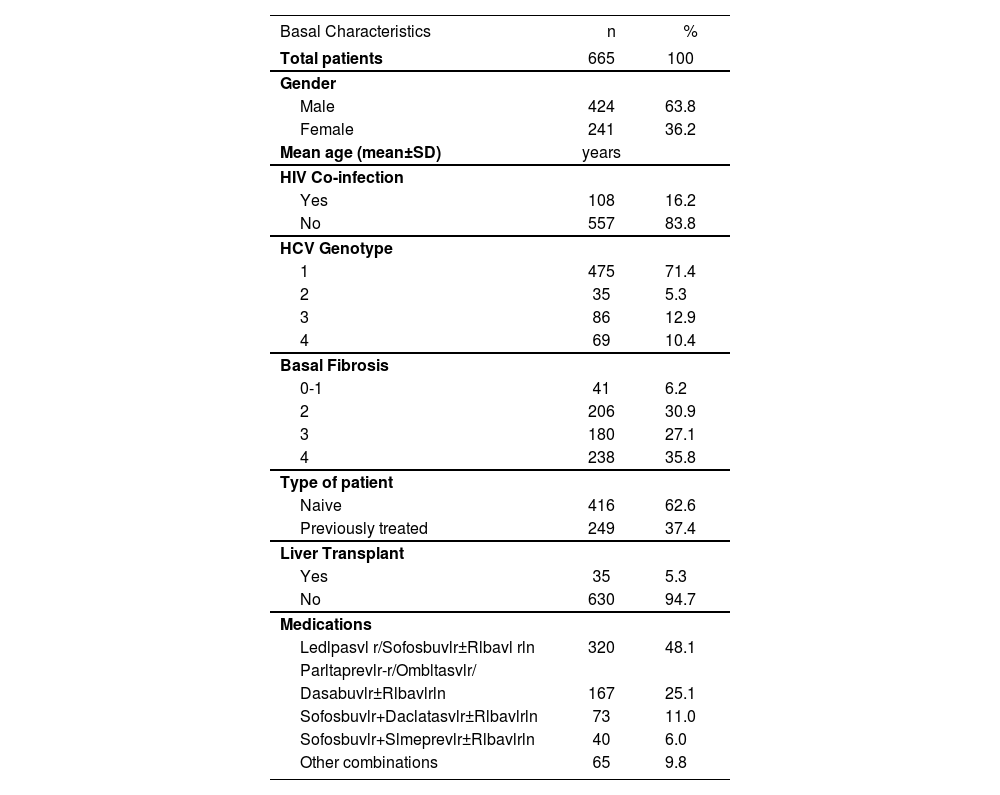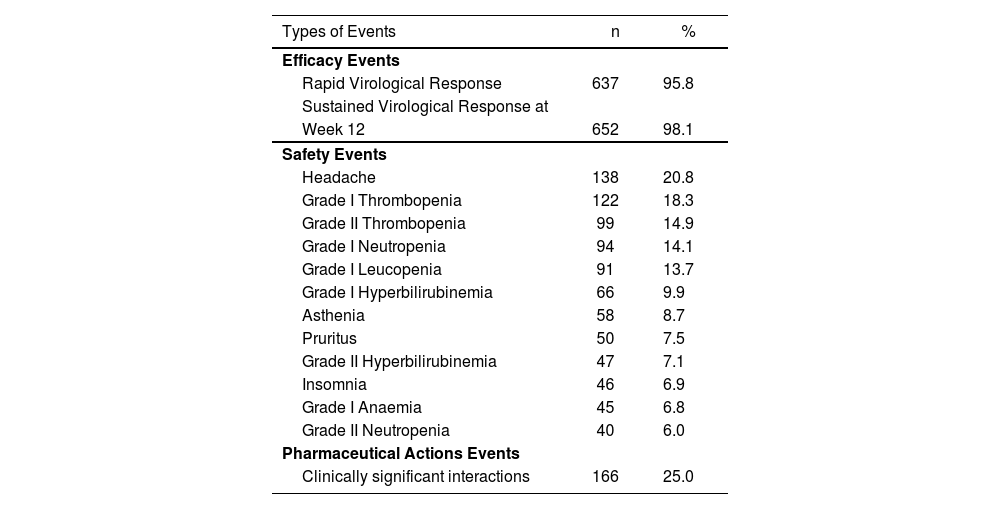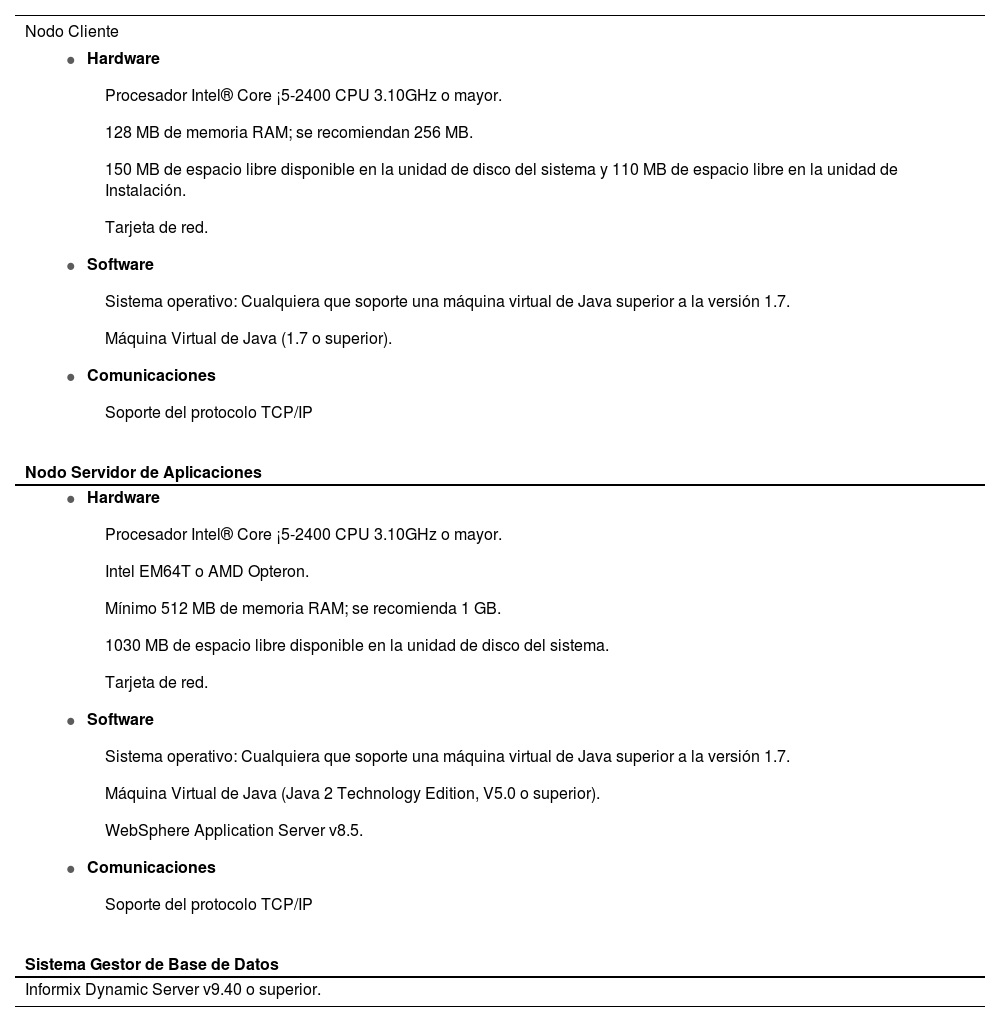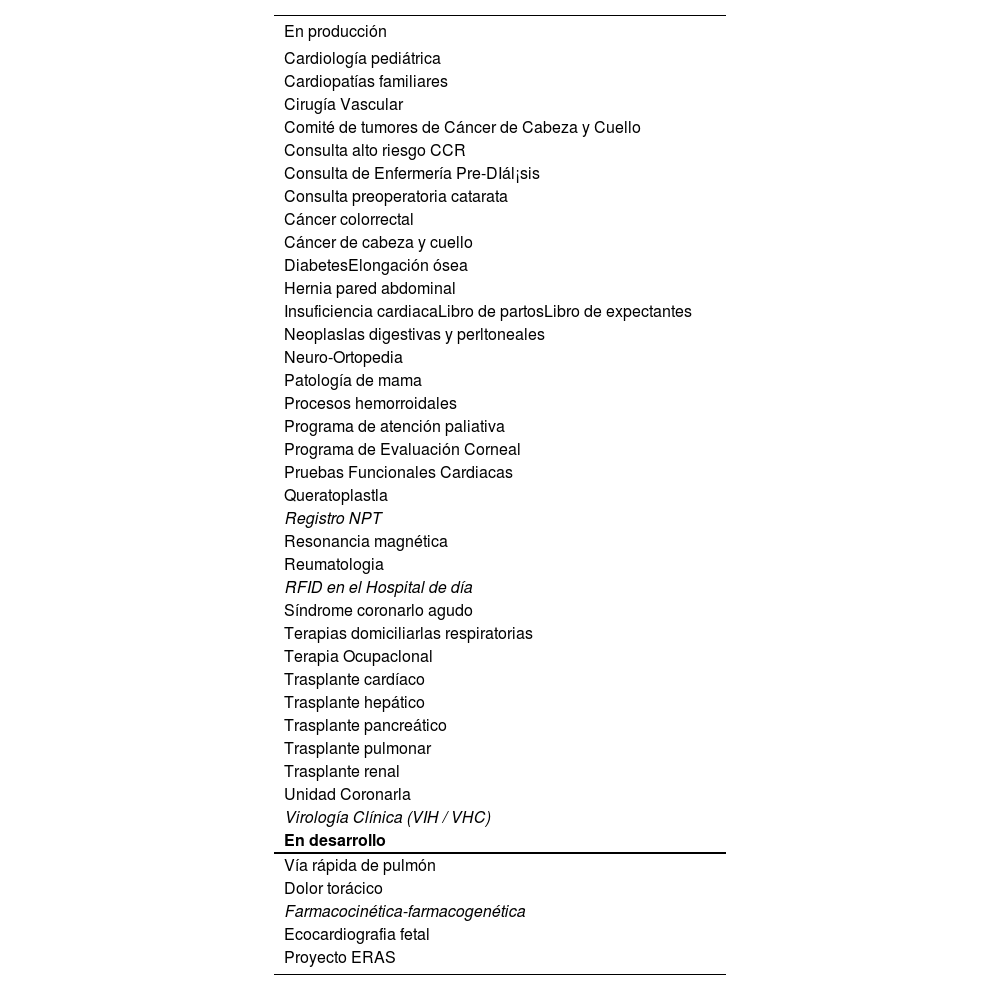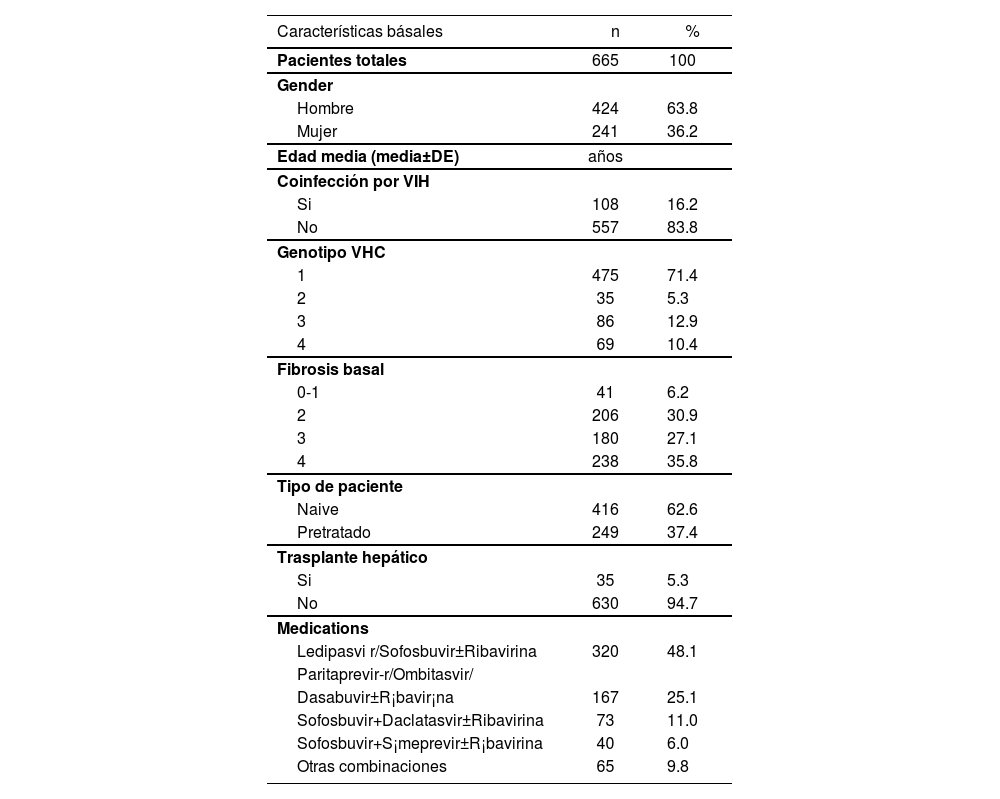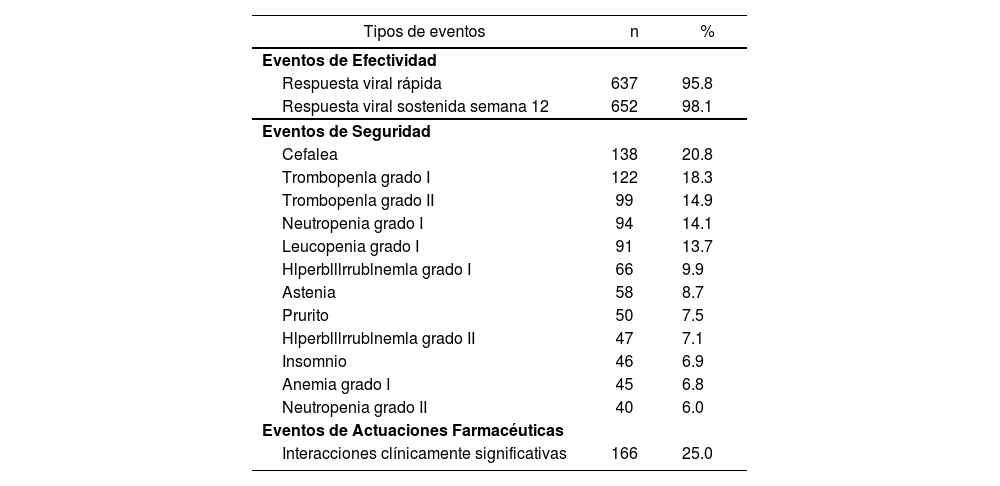Two out of six strategic axes of pharmaceutical care in our hospital are quality and safety of care, and the incorporation of information technologies. Based on this, an information system was developed in the outpatient setting for pharmaceutical care of patients with chronic hepatitis C, SiMON-VC, which would improve the quality and safety of their pharmacotherapy. The objective of this paper is to describe requirements, structure and features of SiMON-VC. Requirements demanded were that the information system would enter automatically all critical data from electronic clinical records at each of the visits to the Outpatient Pharmacy Unit, allowing the generation of events and alerts, documenting the pharmaceutical care provided, and allowing the use of data for research purposes. In order to meet these requirements, 5 sections were structured for each patient in SiMON-VC: Main Record, Events, Notes, Monitoring Graphs and Tables, and Follow-up. Each section presents a number of tabs with those coded data needed to monitor patients in the outpatient unit. The system automatically generates alerts for assisted prescription validation, efficacy and safety of using antivirals for the treatment of this disease. It features a completely versatile Indicator Control Panel, where temporary monitoring standards and alerts can be set. It allows the generation of reports, and their export to the electronic clinical record. It also allows data to be exported to the usual operating systems, through Big Data and Business Intelligence. Summing up, we can state that SiMON-VC improves the quality of pharmaceutical care provided in the outpatient pharmacy unit to patients with chronic hepatitis C, increasing the safety of antiviral therapy.
Dos ejes estratégicos de la atención farmacéutica en nuestro hospital son la calidad y seguridad asistencial y la incorporación de tecnologías de la información. En base a ellos, en el ámbito de pacientes externos, se desarrolló un sistema de información para la atención farmacéutica de pacientes con hepatitis C crónica, SiMON-VC, que mejorase la calidad y seguridad de su farmacoterapia. El objetivo de este trabajo es describir requisitos, estructura y prestaciones de SiMON-VC. Los requisitos exigidos fueron que el sistema de información incorpore automáticamente datos críticos desde la historia clínica electrónica en cada una de las visitas a consulta externa de Farmacia, que permita la generación de eventos y alertas, que documente la atención farmacéutica proporcionada y que posibilite la explotación de los datos con fines de investigación. Para cumplir estos requisitos SiMON-VC se estructuraron 5 apartados para cada paciente: Registro Principal, Eventos, Notas, Gráfica y Tablas de Seguimiento y Seguimientos. Cada apartado dispone de una serie de pestañas con datos codificados necesarios para el seguimiento del paciente en consulta externa. El sistema genera automáticamente alertas de efectividad y seguridad de la utilización de antivirales para el tratamiento de esta patología y como sistema de ayuda a la validación farmacéutica de la prescripción médica. Incorpora un Cuadro de Mando de Indicadores totalmente versátil, para el que se pueden definir estándares y alertas de seguimiento temporales. Permite la generación de informes y su exportación hacia la historia clínica electrónica. Posibilita la exportación de los datos a los sistemas de explotación habituales, con fines de investigación a través de Big-Data y Business IntelIigence. Como conclusión se puede indicar que SiMON-VC mejora la calidad de la atención farmacéutica proporcionada en consulta externa de Farmacia a pacientes con hepatitis C crónica, incrementando la seguridad del tratamiento antiviral.
SiMON-VC is the first information system developed for the pharmacotherapeutical monitoring of patients with Chronic Hepatitis C which enters automatically those data included in the electronic clinical record.
It allows a more efficient and safe pharmacotherapeutical follow-up, as well as an on-going improvement in healthcare quality; it promotes co-responsibility in healthcare outcomes, and it facilitates research in health outcomes.
IntroductionThe use of new information technologies in order to improve healthcare of the citizens is one of the strategic lines of the Quality Plan for the National Health System1, which has been the basis for the development of the different healthcare strategies by the Spanish regional healthcare systems. In Galicia, the Strategy by the Servicio Galego de Saúde 20142 incorporates this strategic line, which has been the basis, among other actions, for the development of a single electronic clinical record for the entire regional Primary Care and hospital setting, or for the use of the computerized physician prescription in 100% of the population.
In our hospital, and as part of this strategy, the Information Systems Unit has developed an information system with a specific technological setting (Table 1), named with the acronym SiMON, for „Sistema inteligente de MONito- rización de pacientes“ (Intelligent System for Patient Monitoring); its objective is to increase the efficacy in patient care and help physicians and pharmacists to make decisions, through the automation of the information available about the product at each time point within the hospital setting. The Pharmacy Unit has joined this system (Table 2), through the implementation of three protocols already in production (follow-up of patients with Chronic Hepatitis C on antiviral treatment, prescription-validation-preparation of parenteral nutrition formulations, and traceability of biologies through radiofrequency), and one under development (pharmacokinetics, pharmacogenetics).
Technological setting for SIMON
| Client Node |
|---|
|
| Application Server Node |
|
| Database Management System |
| Informix Dynamic Server v9.40 or superior. |
SiMON protocols in production and under development (those implemented from the Pharmacy Unit are in cursive letter)
| In production |
|---|
| Paediatric Cardiology |
| Familial Cardiopathies |
| Vascular Surgery |
| Tumour Committee for Head and Neck Cancer |
| High risk CRC Unit |
| Pre-dialysis Nursing Unit |
| Cataract Pre-operative Unit |
| Colorectal Cancer |
| Head and Neck Cancer |
| Diabetes |
| Bone Elongation |
| Abdominal Wall Hernia |
| Heart Failure |
| Book of Labours |
| Book of Pregnancies |
| Digestive and Peritoneal Neoplasias |
| Neuro-Orthopedics |
| Breast Conditions |
| Hemorrhoidal Conditions |
| Palliative Care Program |
| Corneal Evaluation Program |
| Heart Function Tests |
| Keratoplasty |
| TPNRecord |
| Magnetic Resonance Imaging |
| Rheumatology |
| RFID at Day Hospital |
| Acute Coronary Syndrome |
| Home Respiratory Therapies |
| Occupational Therapy |
| Heart Transplant |
| Liver Transplant |
| Pancreatic Transplant |
| Lung Transplant |
| Renal Transplant |
| Coronary Unit |
| Clinical Virology (HIV / HCV) |
| Under development |
| Fast Lung Pathway |
| Chest Pain |
| Pharmacokinetics - Pharmacogenetics |
| Fetal Echocardiography |
| Project ERAS |
A core activity by Hospital Pharmacists in Spain consists in Pharmaceutical Care (PhC) for outpatients; in our hospital, this is based on national and international standards, including the Strategy by the Servicio Galego de Saúde 20 1 42, the Quality Plan and Quality Policy of the Hospital, the Quality Handbook by the Pharmacy Unit, and the SEFH 2020 Initiative „Hacia el futuro con seguridad“ (Towards the Future with Safety)3. Based on these fundaments, the Hospital Pharmacy Unit has considered various strategic axes, including Care Quality and Safety and Information Systems and Communication Technologies.
In the setting of PhC for outpatients, these axes have led to opening Monographic Units for Outpatient Pharmaceutical Care, as a central action line; 16 of these units have been established nowadays, managed managed by a Specialist Pharmacist sub-specialized in this monographic area. Since the enforcement of the National Strategic Plan for Addressing Hepatitis C in April, 20 1 54, a Monographic Pharmaceutical Care Unit for Patients with Chronic Hepatitis C was created, based on a pre-existent Monographic Unit for Viral Conditions (HIV, HCV, HBV). One of the objectives of this unit was to develop an Information System to promote:
- •
The quality and efficiency of PhC, through an automatic system for patient information associated with the Outpatient Pharmacy Unit.
- •
Patient safety during antiviral treatment.
- •
Research on health outcomes.
And under these premises, an Intelligent System for Monitoring Clinical Virology (SiMON-VC) was developed, in collaboration with the Information Systems Unit and the Internal Medicine Unit responsible for the medical follow-up of patients with this condition.
The objective of this article is to describe the requirements, structure and features of SiMON-VC.
MethodThe design of this information system for therapeutical monitoring and research of HCV patients on antiviral treatment was developed by the Pharmacists responsible for Pharmaceutical Care in the Monographic Outpatient Unit and with the computer technicians in the Information Systems Unit, during bi-weekly meetings over the period of one year.
The final conclusion was that the design of SiMON-VC should allow to:
- •
Record patients with Chronic Hepatitis C on treatment, with automatic incorporation of basal and epidemiological data of the patient from their electronic clinical record.
- •
To record PhC follow-ups in the Monographic Unit, automatically incorporating blood, biochemical and microbiological tests from the Lab databases.
- •
To generate events and automatic pharmaceutical alerts regarding the efficacy and safety of pharmacological treatment.
- •
To estimate patient adherence to antiviral treatment.
- •
To document Pharmacy visits in the electronic clinical record, by exporting the records of Pharmaceutical Care.
- •
To generate an Activity Control Panel and a Quality Control Panel, with automatic generation of indexes and alerts about the standards determined.
- •
Statistical treatment of Big Data through Business Intelligence (Bl) tools.
- •
Maximum versatility in the use of data.
Based on these requirements, SiMON-VC was designed with the structure and performance features detailed below.
ResultsSiMON-VC structureSiMON-VC features a Main Menu shown in Figure 1, which can be accessed by the individualized passwords for each Pharmacist; this menu has been structured into two sections containing the following tabs with different functions:
- •
Upper section (grey background)
- -
Insert record: It allows to enter each antiviral treatment course for a patient.
- -
Agenda: Shows a list of patients with previous appointment for the Pharmaceutical Care Unit.
- -
Search patient, Search by ID, List: Tabs to locate registered patients.
- -
Control Panel: Incorporates activity and quality indexes. - Insert monitoring: Generates a record of the objective and subjective data generated in each one of the patient visits.
- -
Sign: Records electronically every follow-up visit in the electronic clinical record.
- -
Import: Allows access to all pre-determined data in the clinical patient record.
- -
Reports: Generates reports with data selected by the Pharmacist.
- -
- •
Lower section (white background, left side): After each patient record, it enters in the form of a tree the following options:
- -
Main record.
- -
Events.
- -
Notes.
- -
Monitoring graph.
- -
Monitoring table.
- -
Follow-up visits (with the dates for each patient visit to the Pharmacy Unit).
- -
- •
Lower section (White background, right side): It shows the contents of each option in the tree. It is described below.
Each patient is assigned a Main Record for each antiviral treatment course. As can be observed in Figure 1, this is structured into three tabs, where the majority of data from the electronic clinical record are automatically entered:
- •
Record data:
- -
Patient Identification (name and clinical record number).
- -
Date and internal record number for SiMON-VC.
- -
Diagnosis: Hepatitis C.
- -
Basics:
- -
Age, gender, ethnicity, height, liver transplant (yes/ no).
- -
- •
Epidemiology:
- -
Year of diagnosis and infection transmission pathway.
- -
Co-infection with HAV, HBV, HIV (yes/no). Syphilis (yes/no).
- -
HCV genotype and IL28B polymorphism.
- -
Response to previous treatments (naive, relapsing, partial response, no response, unknown previous response).
- -
Antiviral treatment: Initial and final dates.
- -
Initial and final fibrosis.
- -
Sustained Virological Response (SVR: yes/no).
- -
One of the most important functions in SiMON-VC is based upon the Events associated with treatment efficacy and safety or pharmaceutical actions. Events are pre-determined through algorithms in the computer structure of SiMON-VC, and after incorporating the defining data automatically from the electronic clinical record, they appear as an alert in the computer screen. They can be entered and subsequently processed, either through an Indicator Control Panel, or statistically for research studies.
b.1. Treatment Efficacy EventsRegarding treatment efficacy, SiMON-VC includes different types of response in a coded manner, which will appear as an event/alert when data from the Microbiology Lab are automatically entered in a follow-up visit. Events are defined as the efficacy variables from the antiviral treatment against HCV: RVR-Rapid Virological Response (undetectable HCV RNA at week 4 of treatment), EVR-Early Virological Response (undetectable HCV RNA at week 12 of treatment), FVR-Final Virological Response (undetectable HCV RNA at the end of the treatment), and SVR-Sustained Virological Response (un-detectable HCV RNA at week 12 after completing the treatment). For example, if a patient presents negative HCV virological load at week 4 of antiviral treatment, SiMON-VC will automatically generate the event „Rapid Virological Response-RVR“, it will be registered as such, and it can be used for patient care or research purposes, because it is a „coded“ computer record.
At the same time, alerts have been included for Discontinuation Rules of the antiviral treatment, during the use of dual therapy based on Pegylated Interferon + Ribavirin, and triple therapy based on first-generation Protease Inhibitors.
b.2. Treatment safety events. AlertsEvents associated with treatment safety are entered manually during the clinical interview with the patient by the Pharmacist in the Outpatient Unit, selecting those adverse events reported by the patient from a predefined database that includes all adverse events described for the antiviral treatment.
Safety events are also automatically generated, which appear as SiMON-VC alerts, with the objective of being support systems for decision making. For example, events associated with potential contraindications of the antiviral treatment according to the basal data of the patient, lab data from the patient, or events associated with incorrect dosing. Based on event generation the system will suggest a recommendation or pharmaceutical action according to the alert issued.
Safety alerts for haematological adverse events have also been predefined according to their severity, and these are automatically generated and entered based on the blood parameters of the patient. Thus, for example, if a patient presents a haemoglobin level of 8 g/dL in a specific follow-up visit, the system will generate a „Grade III Anaemia“ alert, and record it as an event.
Alerts for clinically significant interactions have also been predefined for each one of the medications used.
b.3. Pharmacist Action EventsAnother type of coded events are those associated with Pharmacist actions derived from the clinical interview between Pharmacist and patient, and from the safety alerts generated in the visit by the patient. In total, 12 types of Pharmacy Interventions have been coded.
As an example, Figure 2 shows the events generated in that specific date for a patient throughout their pharmacotherapeutical follow-up, and associated with treatment efficacy (RVR: Rapid Virological Response), safety (Grade 1 Thrombocytopenia, fatigue, confusion, headache, insomnia) or active pharmaceutical actions such as drug-drug interaction, drug-food interaction, or information on medications.
c) NotesThis is an uncoded free-text field (and therefore, it cannot generates a computer network exploitation), where the Pharmacist enters various aspects associated with patient follow-up (for example: „reinforce information in the next visit“, „analyze digoxin pharmacokinetics by pharmacological interaction“, etc.).
d) Monitoring GraphsThis SiMON-VC option allows to design temporary graphs that will show the evolution of patient parameters and treatments throughout all the monitoring conducted:
- •
Hepatic fibrosis grade of the patient.
- •
Treatment adherence.
- •
Blood count and biochemical tests.
- •
Child-Pugh Score.
- •
HCV viral load.
This is the table option by monitoring date, which allows the design of the Monitoring Graphs previously described. Figure 3 shows the Monitoring Graph for platelet count recovery of a patient throughout their treatment.
f) Follow-up VisitsThe essential option in SiMON-VC is Follow-up Visits, where the greatest part of the information for the system is generated for each patient during their pharmacological treatment. The number of Follow-up Visits for each patient is equal to their number of visits to the Pharmacy Unit, including the first one on the day of treatment initiation, and the last follow-up visit (and closure of the patient record), at 12-24 weeks after the day of pharmacological treatment completion (with the objective of recording the 12-24 Sustained Virological Response).
Each Follow-up Visit is structured into three tabs, where the greatest part of the electronic clinical record data are entered for the date of that visit; there is stratification by colours of the values based on the normality range, information about the variation in the value compared with the previous follow-up visit, and an alert is generated if a predefined rule is met:
- •
Follow-up Visit:
- -
Date and internal identification number of the follow-up visit.
- -
Follow-up duration (time since the previous follow-up visit recorded).
- -
- •
Parameters:
- -
Age
- -
Treatment week.
- -
HVC RNA.
- -
Treatment adherence for each medication.
- -
Biochemical tests, Blood Counts, Coagulation, Pharmacokinetics, etc.
- -
- •
Treatment:
- -
Medications and dosing regimen.
- -
The follow-up for the Treatment Adherence parameter presents a particular interest in the monographic PhC visit; this is automatically generated in each patient visit, by manually entering the number of remaining dosing units on the day of the visit. An algorithm has been designed to enter the date of the follow-up visit (current and previous), medication units dispensed, and medication stock (current and previous), and the result obtained is the percentage of Treatment Adherence by medication (Figure 4).
SiMON-VC featuresThe main feature of SiMON-VC is being a Pharmaceutical Care supporting system for patients with Chronic Hepatitis C, as shown in the previous chapter describing its structure. Besides, SiMON-VC presents the following features that are developed in a completely versatile setting:
- a)
Report Generation.
- b)
Pharmaceutical Care Documentation.
- c)
Control Panel for Activity, Quality and Safety.
- d)
Research.
SiMON-VC issues reports based on data from the main record or the follow-up visits. Its versatility and autonomy allows selecting the type of report and presenting them as tables or graphs, with transversal or longitudinal monitoring.
b) Pharmaceutical Care DocumentationPhC documentation provided by the Pharmacist for each visit at the Outpatient Pharmacy Unit can be entered into the electronic clinical record by exporting to the clinical course of the patient all monitoring and reports previously recorded and signed by the Pharmacist in charge with their personal password, in order to enter it as a document on its export date. This function has a particular clinical interest in terms of the monitoring, secondary to detecting clinically significant interactions, and monitoring antiviral treatment adherence.
c) Control Panel for Activity, Quality and SafetyAn essential aspect of the program is its potential to design, in a completely automatic and versatile manner, a control panel for Activity, Quality or Safety Indicators, to obtain indexes and generate alerts when previously determined standards are not met. This turns SiMON-VC into a Support System for Decision Making. As can be observed in Figure 1, the „Control Panel“ option is part of the Main Menu in SiMON-VC.
This option also features a self-control system for quality of compliance with the essential basal data, which allows to identify directly those patients for whom these data have not been adequately recorded.
For example, Figure 5 shows the Control Panel in SiMON-VC for the first 2016 trimester, where two alerts for lack of protocol compliance can be seen (ninth line) relative to the proportion of patients with Grade 2 liver fibrosis, and the proportion of patients on a specific antiviral treatment (last line).
d) ResearchA strength in this information system is the potential use with research purposes of a high amount of recor-ded and coded data that are entered or automatically generated in SiMON-VC, at the evaluation level of health outcomes derived of the use of medications and/or the PhC provided, through Big-Data and Bl tools. Data can be exported to a file compatible with most statistical tools (Excel®, SPSS®...).
The program automatically generates graphs representing the analysis outcomes of data pre-determined by the user, both for the overall population registered and for specific patient profiles. Besides, it can create or modify through Bl all types of population analysis, for patient record data as well as for any of the follow-up visits conducted until the end of Pharmaceutical Care in the Outpatient Unit, as shown in the next chapter.
SiMON-VC was implemented on January, 1st, 2012, after a previous validation period, and since then it is the information system used in the PhC Monographic Outpatient Unit for the record and follow-up of Chronic C Hepatitis patients on antiviral treatment. Table 3 shows the basal record data of those patients who initiated an antiviral treatment course between April, 1st, 2015 and April, 1st, 2016 (1 natural year since the implementation of the National Strategic Plan for Addressing Chronic Hepatitis C by the Spanish Government). During this period, 665 patients have initiated antiviral treatment against HCV, and 2,493 follow-up visits have been conducted.
Basal characteristics of patients included in SiMON-VC during the first year after the approval of the National Strategic Plan for Addressing Chronic Hepatitis C (enforced on April, 1st, 2015)
| Basal Characteristics | n | % |
|---|---|---|
| Total patients | 665 | 100 |
| Gender | ||
| Male | 424 | 63.8 |
| Female | 241 | 36.2 |
| Mean age (mean±SD) | years | |
| HIV Co-infection | ||
| Yes | 108 | 16.2 |
| No | 557 | 83.8 |
| HCV Genotype | ||
| 1 | 475 | 71.4 |
| 2 | 35 | 5.3 |
| 3 | 86 | 12.9 |
| 4 | 69 | 10.4 |
| Basal Fibrosis | ||
| 0-1 | 41 | 6.2 |
| 2 | 206 | 30.9 |
| 3 | 180 | 27.1 |
| 4 | 238 | 35.8 |
| Type of patient | ||
| Naive | 416 | 62.6 |
| Previously treated | 249 | 37.4 |
| Liver Transplant | ||
| Yes | 35 | 5.3 |
| No | 630 | 94.7 |
| Medications | ||
| Ledlpasvl r/Sofosbuvlr±Rlbavl rln | 320 | 48.1 |
| Parltaprevlr-r/Ombltasvlr/ | ||
| Dasabuvlr±Rlbavlrln | 167 | 25.1 |
| Sofosbuvlr+Daclatasvlr±Rlbavlrln | 73 | 11.0 |
| Sofosbuvlr+Slmeprevlr±Rlbavlrln | 40 | 6.0 |
| Other combinations | 65 | 9.8 |
During this follow-up, automatic and manual events have been generated and entered for each patient, associated with antiviral treatment efficacy and safety, or pharmaceutical interventions. Table 4 includes the main events during the analyzed period.
Efficacy, Safety, and Pharmaceutical Actions Events generated
| Types of Events | n | % |
|---|---|---|
| Efficacy Events | ||
| Rapid Virological Response | 637 | 95.8 |
| Sustained Virological Response at | ||
| Week 12 | 652 | 98.1 |
| Safety Events | ||
| Headache | 138 | 20.8 |
| Grade I Thrombopenia | 122 | 18.3 |
| Grade II Thrombopenia | 99 | 14.9 |
| Grade I Neutropenia | 94 | 14.1 |
| Grade I Leucopenia | 91 | 13.7 |
| Grade I Hyperbilirubinemia | 66 | 9.9 |
| Asthenia | 58 | 8.7 |
| Pruritus | 50 | 7.5 |
| Grade II Hyperbilirubinemia | 47 | 7.1 |
| Insomnia | 46 | 6.9 |
| Grade I Anaemia | 45 | 6.8 |
| Grade II Neutropenia | 40 | 6.0 |
| Pharmaceutical Actions Events | ||
| Clinically significant interactions | 166 | 25.0 |
Pharmaceutical Care for outpatients provided by Pharmacy Units in Spanish hospitals is an activity that had its main driver in 1991, with the change of the prescription and dispensing setting for different medicinal products in the National Health System5. Since then, this activity has gradually increased year after year, and different national and international positions have been stated, that have guided Hospital Pharmacists regarding the objectives and procedures to follow in its development 6 putting forward a series of strategies to encourage patient-centered Pharmaceutical Care, collaboration in multidisciplinary teams, documentation of the care provided, and joint responsibility in health outcomes.
More recently, in the past two decades, different initiatives have been driven by the professional associations of reference in the Spanish Hospital Pharmacy setting; these have encouraged new strategic lines to be implemented in general Hospital Pharmacy practice, and particularly in the outpatient practice, such as the development of new technologies and integrated information systems, patient care quality and safety, and research15-30. Aligned with these strategic lines, Spanish Hospital Pharmacy Units have developed numerous actions focused on the implementation of Assisted prescription programs for Computerized Physician Order Entry, both for hospitalized patients and outpatients, following the initiatives by the Spanish Society of Hospital Pharmacy21; they have driven the certification by authorized companies of the quality developed, and they have encouraged research, particularly in the field of health outcomes by new pharmacological treatments.
However, Pharmacotherapeutical Monitoring is a core procedure in the Hospital Pharmaceutical Care area, where no tools have been developed to meet these strategic lines previously mentioned (information systems, quality-safety and research). In this sense, SiMON-VC is the first integrated information system developed in Spain that facilitates the pharmacotherapeutical monitoring of patients under the responsibility of the Hospital Pharmacist, specifically outpatients infected with Hepatitis C virus who are on antiviral treatment.
As has been shown in the previous sections about the structure and features of SiMON-VC, this information system meets all requirements initially proposed for its development, by maximizing the quality of the Pharmaceutical Care provided in the Outpatient Pharmacy Unit, and increasing antiviral treatment safety.
Firstly, SiMON-VC is a very versatile information system constantly updated, because it is developed through the on-going collaboration between pharmacists and physicians responsible for HCV patient care and the Hospital Information System Units. This allows to avoid unnecessary latency periods at the time of updating medications, clinical variables, or new alerts issued by Spanish or European regulating agencies. And at the same time, it strengthens the multidisciplinary collaboration of healthcare professionals managing the patient, not only through its technological development, but also through its joint use in patient visits to the physician and the pharmacy.
This system is integrated with the rest of information systems in the hospital, which allows the automatic entry of all parametric data in the rest of the hospital information systems (admission, biochemistry, blood count, coagulation, microbiology, anatomopathology, etc.), thus reducing as much as possible the time required and the potential errors derived from the manual entry of variables. All information systems used by all hospital units can be integrated with SiMON-VC.
Through the Record, Basics and Epidemiology Data from the Main Record, SiMON-VC generates a database including all HCV patients seen in the Pharmacy Unit, with those records required for a subsequent joint or stratified use of patient data for research purposes.
Some essential aspects in the pharmacotherapeutical monitoring of outpatients are: assessment of treatment efficacy and safety, adherence to the treatment dispensed in the Pharmaceutical Care Unit, or drug-drug or drug-food interactions. SiMON-VC incorporates all these aspects, which can be automatically included from the clinical record or manually entered during the Pharmacist-patient clinical interview; the required variables include HCV viral load before and during treatment and after its completion, lab values (biochemical, blood tests...), records of dispensing and return of medications or concomitant medications. And also from the perspective of Pharmaceutical Care, SiMON-VC allows to enter all Pharmacist actions provided to the patient.
A key aspect of the information system from the perspective of patient care safety is the previous definition and automatic generation of safety alerts during the Pharmaceutical Care visit, both regarding indication-contraindication, clinically significant interactions, or dosing regimen of the pharmacological treatment, and therapy outcomes in terms of safety (for example, development of severe haematological effects) and efficacy (for example, lack of response or virological relapse). The alerts generated allow the Pharmacist to take proactive actions regarding pharmacological treatment (dose adjustment, recommendation for pharmacokinetic monitoring, or close blood pressure monitoring in case of interactions, for example) in collaboration with the hospital physician responsible for the patient as well as with their Primary Care physician or pharmacist.
On the other hand, the potential to design and generate predefined reports with the relevant information about pharmacotherapeutical monitoring (for example, graphs of adherence to antiviral treatment, development of adverse effects, or specific recommendations) and their export through digital signature to the electronic clinical record, will not only allow to document the Pharmaceutical Care provided, but also to share this information with the rest of the healthcare team managing these patients.
Moreover, SiMON-VC is a support system for decision making, which allows to define an Indicator Control Panel, with alerts when those standards determined are not met in terms of demographical data, antiviral treatment, etc. This function is widely used as a tool for the economic management of a very effective but undoubtedly costly treatment, because it allows to know not only the number of patients treated during the period of time selected, but also their stratification according to type of patient (HIV coinfection, transplant, initial fibrosis, previous treatment...) or type of antiviral treatment prescribed.
Finally, as described in the Features Section, SiMON-VC is an extremely potent tool for using codified data for research purposes, through the development of the Big-Data and Bl tools. All patient data included in the information system can be extracted for the generation of populations or sub-populations, sorted per condition required during a specific period of study, or exported to dynamic tables to allow their joint use. Besides, it is compatible with the main programs for data use and statistics, such as Excel® or SPSS®.
Logically, SiMON-VC presents limitations; from our point of view, the main one is that it does not allow to enter automatically from the pharmacotherapeutical history of the patient all their pharmacological treatment, both prescribed in the hospital setting and out of hospital, which therefore must be entered manually and requires a review (already routinely conducted) at each patient visit to the Pharmaceutical Care Unit. A constant update is also required, for example regarding the design of alerts, rules for action, or antiviral treatment contraindication.
Summing up, SiMON-VC is a pioneer information system in Spain; it is flexible, and allows to have a protocol designed by the same specialists involved in healthcare management of HCV patients. It incorporates, in a dynamic and intuitive way, all patient information required, with functions also in the setting of quality, safety, management and research; and it also encourages compliance of the strategic lines for the professional development of Hospital Pharmacists.
FundingNo funding.
Conflict of interestsNo conflict of interests.
Aportacion a la literatura científicaSiMON-VC es el primer sistema de información desarrollado para el seguimiento farmacoterapéutico de pacientes con hepatitis C crónica, que incorpora automáticamente datos registrados en la historia clínica electrónica.
Permite un seguimiento farmacoterapéutico más eficiente y seguro, una mejora continua de la calidad asistencial, promueve la corresponsabilidad en el resultado asistencial y facilita la investigación en resultados en salud.
IntroducciónLa utilización de las nuevas tecnologías de la información para mejorar la atención de los ciudadanos es una de líneas estratégicas del Plan de Calidad para el Sistema Nacional de Salud1, que ha servido como base al desarrollo de las distintas estrategias sanitarias de los sistemas autonómicos de salud españoles. En Galicia, la Estrategia del Servicio Galego de Saúde 20142 incorpora esta línea estratégica, que ha servido de base, entre otras actuaciones, al desarrollo de una historia clínica electrónica única para todo el ámbito regional en atención primaria y hospitalaria o a la prescripción en receta electrónica al 100% de la población atendida.
En nuestro hospital, el Servicio de Sistemas de Información, como parte de esta estrategia, ha desarrollado un sistema de información con un entorno tecnológico específico (Tabla 1) denominado mediante el acrónimo SiMON (Sistema inteligente de MONinitorización de pacientes) con el objetivo de hacer más eficiente la atención al paciente y ayudar al facultativo en la toma de decisiones, mediante la automatización de la información disponible del paciente en cada momento dentro del entorno hospitalario. El Servicio de Farmacia se ha incorporado a este sistema (Tabla 2), mediante la implantación de tres protocolos ya en producción (seguimiento de pacientes con hepatitis C crónica a tratamiento antiviral, prescripción-validación-elaboración de mezclas de nutrición parenteral y trazabilidad de medicamentos biológicos mediante radiofrecuencia) y uno en desarrollo (farmacocinética-farmacogenética).
Entorno tecnológico de SiMON.
| Nodo Cliente |
|---|
|
| Nodo Servidor de Aplicaciones |
|
| Sistema Gestor de Base de Datos |
| Informix Dynamic Server v9.40 o superior. |
Protocolos SIMON en producción y en desarrollo (en letra cursiva los implantados desde el Servicio de Farmacia)
| En producción |
|---|
| Cardiología pediátrica |
| Cardiopatías familiares |
| Cirugía Vascular |
| Comité de tumores de Cáncer de Cabeza y Cuello |
| Consulta alto riesgo CCR |
| Consulta de Enfermería Pre-DIál¡sis |
| Consulta preoperatoria catarata |
| Cáncer colorrectal |
| Cáncer de cabeza y cuello |
| DiabetesElongación ósea |
| Hernia pared abdominal |
| Insuficiencia cardiacaLibro de partosLibro de expectantes |
| Neoplaslas digestivas y perltoneales |
| Neuro-Ortopedia |
| Patología de mama |
| Procesos hemorroidales |
| Programa de atención paliativa |
| Programa de Evaluación Corneal |
| Pruebas Funcionales Cardiacas |
| Queratoplastla |
| Registro NPT |
| Resonancia magnética |
| Reumatologia |
| RFID en el Hospital de día |
| Síndrome coronarlo agudo |
| Terapias domiciliarlas respiratorias |
| Terapia Ocupaclonal |
| Trasplante cardíaco |
| Trasplante hepático |
| Trasplante pancreático |
| Trasplante pulmonar |
| Trasplante renal |
| Unidad Coronarla |
| Virología Clínica (VIH / VHC) |
| En desarrollo |
| Vía rápida de pulmón |
| Dolor torácico |
| Farmacocinética-farmacogenética |
| Ecocardiografia fetal |
| Proyecto ERAS |
Una actividad central del farmacéutico de hospital en España es la atención farmacéutica a pacientes externos que, en nuestro hospital, se fundamenta en estrategias y estándares nacionales e internacionales, entre las que caben destacar la Estrategia del Servicio Galego de Saúde 201 42, Plan de Calidad y Política de Calidad del Hospital, Manual de Calidad del Servicio de Farmacia y la Iniciativa SEFH 2020 „Hacia el futuro con seguridad“3. En base a estos fundamentos, el Servicio de Farmacia de hospital ha planteado varios ejes estratégicos, entre los que se encuentran la Calidad y Seguridad Asistencial y Sistemas de Información y Tecnologías de la Comunicación.
En el ámbito de la atención farmacéutica a pacientes externos, dichos ejes han derivado, como línea de actuación central, en la apertura de Consultas Monográficas de Atención Farmacéutica, hasta un total de 16 en la actualidad, atendidas por un farmacéutico sub-es- pecializado en patologías específicas. Desde la entrada en vigor del Plan Estratégico Nacional para el Abordaje de la Hepatitis C en abril 20 1 54, se creó, a partir de una Consulta Monográfica de Patologías Víricas pre-existen- te (VIH, VHC, VHB), una Consulta Monográfica Atención Farmacéutica Pacientes con Hepatitis C Crónica. Entre los objetivos de esta consulta se planteó el desarrollo de un Sistema de Información que promoviera:
- •
La calidad y eficiencia de la AF, automatizando la información del paciente relacionada con la Consulta Externa de Farmacia.
- •
La seguridad de los pacientes durante el tratamiento antiviral.
- •
La investigación sobre resultados en la salud.
Y con estas premisas se desarrolló un Sistema inteligente de Monitorización de Virología Clínica (SiMON-VC), en colaboración con el Servicio de Sistemas de Información y el Servicio de Medicina Interna responsable del seguimiento médico de los pacientes con esta patología.
El objetivo de este trabajo es describir requisitos, estructura y prestaciones de SiMON-VC.
MétodoEl diseño de este sistema de información para seguimiento terapéutico e investigación de pacientes VHC en tratamiento antiviral, fue desarrollado por los farmacéuticos responsables de la atención farmacéutica de la consulta externa monográfica y con los informáticos del servicio de Sistemas de la Información, en reuniones quincenales durante un período de un año.
Finalmente se concluyó que el diseño de SiMON-VC debería permitir:
- •
Registrar pacientes con hepatitis C crónica en tratamiento, con incorporación automática de los datos básales y epidemiológicos del paciente desde la historia clínica electrónica.
- •
Registrar seguimientos de AF en la Consulta Monográfica, que incorpore automáticamente los análisis hematológicos, bioquímicos y microbiológicos desde las bases de datos del Laboratorio.
- •
Generar eventos y alertas farmacéuticas automáticas en relación con la eficacia y seguridad del tratamiento farmacológico.
- •
Calcular la adherencia del paciente al tratamiento antiviral.
- •
Documentar la consulta farmacéutica en la historia clínica electrónica, mediante la exportación de los registros de atención farmacéutica.
- •
Generar un Cuadro de Mando de Actividad y un Cuadro de Mando de Calidad, con generación automática de índices y de alertas sobre los estándares predefinidos.
- •
Tratamiento estadístico de Big Data a través de herramientas de Business Intelligence (Bl).
- •
Máxima versatilidad en explotación de datos.
En base a estos requisitos, se diseñó SiMON-VC con la estructura y prestaciones que se detallan a continuación.
ResultadosEstructura SiMON-VC.SiMON-VC dispone de un menú principal que muestra la Figura 1, al que se accede con las claves individualizadas de cada farmacéutico y que se estructura en dos partes que contienen las siguientes pestañas con las diversas funcionalidades:
- •
Parte superior (fondo gris)
- -
Insertar registro: Permite registrar cada ciclo de tratamiento antiviral de un paciente.
- -
Agenda: Muestra un listado de los pacientes con cita previa el día de consulta de atención farmacéutica.
- -
Buscar paciente, Búsqueda por ID, Listado: pestañas para localizar pacientes registrados.
- -
Cuadro de Mando: Incorpora indicadores de actividad y calidad.
- -
Insertar seguimiento: Genera un registro de los datos objetivos y subjetivos generados en cada una de las consultas con el paciente.
- -
Firmar: Registra electrónicamente cada seguimiento en la historia clínica electrónica.
- -
Importar: Permite el acceso a todos los datos parame- trizados de la historia clínica del paciente.
- -
Informes: Genera informes con datos seleccionados por el farmacéutico.
- -
- •
Parte inferior (fondo blanco, parte izquierda): tras el registro de un paciente incorpora en forma de árbol las siguientes opciones:
- -
Registro principal.
- -
Eventos.
- -
Notas
- -
Gráfica de seguimiento
- -
Tabla de seguimiento.
- -
Seguimientos (con las fechas de cada una de las consultas del paciente en el Servicio de Farmacia).
- -
- •
Parte inferior (fondo blanco, parte derecha): muestra el contenido de cada una de las opciones del árbol anterior. Se describe a continuación.
Cada paciente tiene asignado un registro principal para cada ciclo de tratamiento antiviral. Como se observa en la Figura 1, se estructura en tres pestañas donde se incorporan de forma automática la mayoría de los datos de la historia clínica electrónica:
- •
Datos registro:
- -
Identificación paciente (nombre y número de historia clínica).
- -
Fecha y número de registro interno de SiMON-VC.
- -
Diagnóstico: hepatitis C.
- -
- •
Básicos:
- -
Edad, género, raza, talla, trasplante hepático (si/no).
- -
Epidemiología.
- -
Año diagnóstico y vía de transmisión.
- -
Coinfección VHA, VHB, VIH (si/no). Sífilis (si/no) - Genotipo VHC y Polimorfismo IL28B.
- -
Respuesta a tratamientos previos (nai've, recidivante, respondedor parcial, respondedor nulo, respuesta previa desconocida).
- -
Tratamiento antiviral. Fecha inicial y final.
- -
Fibrosis inicial y final.
- -
Respuesta viral sostenida (RVS: si/no).
- -
Una de las funcionalidades más importantes de SiMON-VC se basa en los Eventos relacionados con la efectividad y seguridad del tratamiento o con las actuaciones farmacéuticas. Los Eventos se predefinen mediante algoritmos en la estructura informática de SiMON-VC y tras incorporar de forma automática desde la historia clínica electrónica los datos que lo definen, surgen como una alerta informática en la pantalla del ordenador. Pueden ser incorporados y ser tratados posteriormente bien a través de un cuadro de mando de indicadores o estadísticamente para estudios de investigación.
b.1. Eventos de efectividad del tratamientoEn cuanto a la efectividad del tratamiento, SiMON-VC incorpora varios tipos de respuesta de forma codificada, que surgen como evento/alerta cuando los datos de Laboratorio de Microbiología se incorporan de forma automática en una visita de seguimiento. Se han definido como eventos las variables de efectividad propias del tratamiento antiviral frente a VHC: RVR-Respuesta Viral Rápida (negativización ARN-VHC a la semana 4 de tratamiento), RVTe- RV Temprana (negativización ARN-VHC a la semana 12 de tratamiento), RVF-RV Final (negativización ARN-VHC al final del tratamiento) y RVS-RV Sostenida (negativización ARN-VHC 12 ó24 semanas después de finalizado el tratamiento). Por ejemplo, si un paciente negativiza la carga viral del VHC a la semana 4 de tratamiento antiviral, SiMON-VC genera automáticamente el evento „Respuesta Viral Rápida-RVR“, queda registrado como tal y puede ser explotado con fines asistenciales o de investigación ya que es un registro informático „codificado“.
Asimismo, se han incorporado alertas sobre las Reglas de Parada del tratamiento antiviral, durante la utilización de biterapia basada en Peglnterferón + Ribavirina y triterapia basada en los Inhibidores de Proteasa de primera generación.
b.2. Eventos de seguridad del tratamiento. AlertasLos eventos relacionados con la seguridad del tratamiento, se incorporan manualmente durante la entrevista clínica al paciente por parte del farmacéutico de consulta externa seleccionando los efectos adversos que indique el paciente de una base de datos predefinida donde se recogen todos los efectos adversos descritos para el tratamiento antiviral.
También se generan eventos de seguridad de forma automática que surgen como alertas de SiMON-VC, con el objetivo de que sean sistemas de apoyo a la toma de decisiones. Por ejemplo, eventos relacionados con posibles contraindicaciones del tratamiento antiviral en función de los datos básales del paciente o datos de laboratorio del paciente o eventos relacionados con dosificaciones incorrectas. A partir de la generación del evento, el sistema propone una recomendación o actuación farmacéutica en función de la alerta que emitida.
Se han predefinido además las alertas de seguridad de los efectos adversos hematológicos en función de su gravedad y se generan e incorporan de manera automática en función de los datos hematimétricos del paciente. Así, por ejemplo, si un paciente en un seguimiento determinado tiene una cifra de hemoglobina de 8 g/dL, el sistema genera una alerta de „Anemia Grado III“ y la registra como evento.
También se han predefinido las alertas de interacciones clínicamente significativas para cada uno de los medicamentos utilizados.
b.3. Eventos de actuaciones farmacéuticas.Otro tipo de eventos codificados son los relacionados con las actuaciones farmacéuticas derivadas de la entrevista clínica entre farmacéutico-paciente y de las alertas de seguridad generadas en la consulta con el paciente. Se han codificado un total de 12 tipos de intervenciones farmacéuticas.
A modo de ejemplo, la Figura 2 muestra los eventos generados en la fecha señalada para un paciente a lo largo de su seguimiento farmacoterapéutico y relacionadas con la efectividad del tratamiento (RVR: respuesta viral rápida), seguridad (trombocitopenia grado 1, cansancio, estado de confusión, cefalea, insomnio) o actuaciones farmacéuticas activas como las interacción medicamento-medicamento (M-M), interacciones medicamento-alimento (M-A) o información de medicamentos.
c) NotasEs un campo de texto libre no codificado (por tanto no explotable informáticamente), donde el farmacéutico registra aspectos varios relacionados con el seguimiento del paciente (por ejemplo, „reforzar información en siguiente visita a consulta“, „analizar la farmacocinética de digoxina por interacción farmacológica“, etc).
d) Gráficas de SeguimientoEsta opción de SiMON-VC permite el diseño de gráficas temporales que muestran la evolución de parámetros y tratamientos del paciente a lo largo de todos los seguimientos realizados:
- •
Grado de fibrosis del paciente.
- •
Adhesión al tratamiento.
- •
Hematimetría y Bioquímica.
- •
índice de Child-Pugh.
- •
Carga viral VHC.
Es la opción tabulada por fecha de seguimiento que permite el diseño de las Gráficas de Seguimiento descritas anteriormente. La Figura 3 muestra la gráfica de seguimiento de la recuperación del recuento plaquetario de un paciente a lo largo del tratamiento.
f) SeguimientosLa opción fundamental de SiMON-VC es la de Seguimientos, donde se genera la mayor parte de la información que el sistema incorpora de cada paciente durante su tratamiento farmacológico. Se generan tantos seguimientos por cada paciente como visitas realice a la consulta de farmacia, incluyendo el primer seguimiento el día de inicio de tratamiento y el último seguimiento (y cierre de registro del paciente), 12-24 semanas después de día fin de tratamiento farmacológico (con el objetivo de registrar la respuesta virológica sostenida 12-24).
Cada seguimiento se estructura en tres pestañas que incorporan de forma automática la mayoría de los datos de la historia clínica electrónica correspondientes a la fecha de esta visita, estratifica por colores valores en función del rango de normalidad, informa de la variación del valor con respecto al anterior seguimiento y genera una alerta si cumple una regla predefinida:
- •
Seguimiento:
- -
Fecha y número de identificación interno de seguimiento.
- -
Duración del seguimiento (tiempo transcurrido desde el anterior seguimiento registrado)
- -
- •
Parámetros:
- -
Edad.
- -
Semana de tratamiento.
- -
ARN del VHC.
- -
Adhesión a cada uno de los medicamentos.
- -
Bioquímica, Hematimetría, Coagulación, Farmacoci- nética, etc.
- -
- •
Tratamiento:
- -
Medicamentos y régimen posológico.
- -
De particular interés en la consulta monográfica de AF, es el seguimiento del parámetro adherencia al tratamiento, que se genera automáticamente en cada visita del paciente la incorporar manualmente el número de unidades de dosificación sobrantes el día de la visita. Se ha diseñado un algoritmo que incorpora fecha del seguimiento (actual y previo), unidades de medicamento dispensadas y stock del medicamento (actual y previo) y se obtiene un porcentaje de adhesión por medicamento (Figura 4).
Prestaciones SiMON-VCLa principal prestación de SiMON-VC es como sistema de ayuda a la atención farmacéutica al paciente con hepatitis C crónica, tal y como se ha mostrado en el capítulo anterior donde se ha mostrado su estructura. Además, SiMON-VC presenta las siguientes prestaciones que se desarrollan en un entorno de total versatilidad:
- a)
Generación de Informes.
- b)
Documentación de la Atención Farmacéutica.
- c)
Cuadro de Mando de Actividad, Calidad y Seguridad, d) Investigación.
SiMON-VC emite informes a partir de los datos del registro principal o de los seguimientos. Su versatilidad y autonomía permite seleccionar el tipo de informe y presentarlos en forma de tablas o gráficas, con seguimientos trasversales o longitudinales.
b) Documentación de la Atención FarmacéuticaLa documentación de la AF proporcionada por el farmacéutico en cada visita en Consultas Externa de Farmacia, puede incorporarse en la historia clínica electrónica mediante la exportación al curso clínico del paciente de todos los seguimientos e informes previamente registrados y firmados por el farmacéutico responsable con su clave personal, de manera que se incorpora como documento en la fecha de la exportación del mismo. Esta funcionalidad es de particular interés clínico en relación con el seguimiento secundario a la detección de interacciones clínicamente significativas y en el seguimiento de la adhesión al tratamiento antiviral.
c) Cuadro de Mando de Actividad, Calidad y SeguridadUn aspecto fundamental del programa es la posibilidad de diseñar de forma totalmente automática y versátil un cuadro de mando de indicadores de actividad, calidad o seguridad, obtener índices y generar alertas de incumplimiento de estándares previamente establecidos, lo que convierte a SiMON-VC en un sistema de apoyo a la toma de decisiones. Como se observa en la Figura 1, la opción „Cuadro de Mando“ forma parte del menú principal de SiMON-VC.
Esta opción dispone de un sistema de autocontrol de calidad de cumplimentación de datos básales esenciales, que permite identificar directamente los pacientes en los que no se ha realizado de forma correcta el registro de estos datos.
A modo de ejemplo, la Figura 5 muestra el Cuadro de Mando del SiMON-VC del primer trimestre 2016, donde se observan dos alertas de incumplimiento de protocolo (novena línea) en relación al porcentaje de pacientes con una fibrosis hepática grado 2 y al porcentaje de pacientes en tratamiento con un determinado tratamiento antiviral (última línea).
d) InvestigaciónPunto fuerte de este sistema de información es la posibilidad de utilizar con fines de investigación gran cantidad de datos registrados y codificados que se hayan incluido o generado automáticamente en SiMON-VC, a nivel de evaluación de los resultados sobre la salud derivados de la utilización de medicamentos y/o de la AF proporcionada, mediante herramientas de Big-Data y Bl. Los datos pueden ser exportados a un fichero compatible con la mayoría de herramientas estadísticas (Excel®, SPSS®...).
El programa genera automáticamente las gráficas que representan los resultados del análisis de los datos que el usuario haya predeterminado, tanto de la población general registrada, como de determinados perfiles de pacientes. Además, mediante Bl puede crear o modificar todo tipo de análisis poblacional, tanto de los datos registro del paciente, como de cualquiera de los seguimientos realizados hasta la finalización de la atención farmacéutica en consulta externa, como se muestra en el siguiente capítulo.
SiMON-VC se implantó, tras un período de validación previa, el 1 de enero de 2012 y desde entonces es el sistema de información utilizado en la consulta externa monográfica de AF a pacientes con hepatitis C crónica a tratamiento antiviral para su registro y seguimiento. La Tabla 3 muestra los datos básales de registro de los pacientes que iniciaron un ciclo de tratamiento antiviral desde el 1 de abril 2015 hasta el 1 abril 2016 (1 año natural desde la entrada en vigor del Plan Estratégico
Características básales de los pacientes incluidos en SiMON-VC durante el primer año tras la aprobación del Plan Estratégico Nacional para el abordaje de la Hepatitis C Crónica (entrada en vigor: 1 abril 2015).
| Características básales | n | % |
|---|---|---|
| Pacientes totales | 665 | 100 |
| Gender | ||
| Hombre | 424 | 63.8 |
| Mujer | 241 | 36.2 |
| Edad media (media±DE) | años | |
| Coinfección por VIH | ||
| Si | 108 | 16.2 |
| No | 557 | 83.8 |
| Genotipo VHC | ||
| 1 | 475 | 71.4 |
| 2 | 35 | 5.3 |
| 3 | 86 | 12.9 |
| 4 | 69 | 10.4 |
| Fibrosis basal | ||
| 0-1 | 41 | 6.2 |
| 2 | 206 | 30.9 |
| 3 | 180 | 27.1 |
| 4 | 238 | 35.8 |
| Tipo de paciente | ||
| Naive | 416 | 62.6 |
| Pretratado | 249 | 37.4 |
| Trasplante hepático | ||
| Si | 35 | 5.3 |
| No | 630 | 94.7 |
| Medications | ||
| Ledipasvi r/Sofosbuvir±Ribavirina | 320 | 48.1 |
| Paritaprevir-r/Ombitasvir/ | ||
| Dasabuvir±R¡bavir¡na | 167 | 25.1 |
| Sofosbuvir+Daclatasvir±Ribavirina | 73 | 11.0 |
| Sofosbuvir+S¡meprevir±R¡bavirina | 40 | 6.0 |
| Otras combinaciones | 65 | 9.8 |
Nacional para el Abordaje de la hepatitis C Crónica del Gobierno de España). Durante este período han iniciado tratamiento antiviral frente a VHC un total de 665 pacientes y se han realizado 2.493 seguimientos.
Durante los seguimientos se han generado eventos automatizados y manuales incorporados a cada paciente, tanto relacionados con la efectividad del tratamiento antiviral, su seguridad o intervenciones farmacéuticas. La Tabla 4 incluye los principales eventos durante el período analizado.
Eventos de efectividad, seguridad y actuaciones farmacéuticas generados.
| Tipos de eventos | n | % |
|---|---|---|
| Eventos de Efectividad | ||
| Respuesta viral rápida | 637 | 95.8 |
| Respuesta viral sostenida semana 12 | 652 | 98.1 |
| Eventos de Seguridad | ||
| Cefalea | 138 | 20.8 |
| Trombopenla grado I | 122 | 18.3 |
| Trombopenla grado II | 99 | 14.9 |
| Neutropenia grado I | 94 | 14.1 |
| Leucopenia grado I | 91 | 13.7 |
| Hlperblllrrublnemla grado I | 66 | 9.9 |
| Astenia | 58 | 8.7 |
| Prurito | 50 | 7.5 |
| Hlperblllrrublnemla grado II | 47 | 7.1 |
| Insomnio | 46 | 6.9 |
| Anemia grado I | 45 | 6.8 |
| Neutropenia grado II | 40 | 6.0 |
| Eventos de Actuaciones Farmacéuticas | ||
| Interacciones clínicamente significativas | 166 | 25.0 |
La atención farmacéutica al paciente externo proporcionada desde los servicios de farmacia de hospitales españoles es una actividad que tuvo su principal impulso en el año 1991 con el cambio del ámbito de prescripción y dispensación en distintas especialidades farmacéuticas en el Sistema Nacional de Salud5. Desde entonces, esta actividad ha venido incrementándose año a año y se han sucedido diversos posicionamientos nacionales e internacionales que han guiado a los farmacéuticos de hospital sobre los objetivos y procedimientos a seguir en su desarrollo6,4, proponiendo una serie estrategias que fomentasen la atención farmacéutica centrada en el paciente, la colaboración en equipos multidisciplinares, la documentación de la atención proporcionada y la corresponsabilidad en los resultados sobre la salud.
Más recientemente, en las dos últimas décadas, se han impulsado diversas iniciativas por parte de las asociaciones profesionales de referencia en el ámbito de la farmacia de hospital española que han impulsado nuevas líneas estratégicas a implementar en la prácti-ca farmacéutica hospitalaria general y en la ambulatoria en particular como el desarrollo de nuevas tecnologías y sistemas de información integrados, calidad y seguridad asistencial e investigación15-30. En línea con estas líneas estratégicas, los servicios de farmacia de hospital españoles han desarrollado numerosas actuaciones centradas en la implantación de la prescripción electrónica asistida tanto para pacientes ingresados o externos siguiendo las iniciativas de la Sociedad Española de Farmacia Hospitalaria21, han impulsado la certificación de la calidad desarrollada a través de empresas acreditadas y han fomentado la investigación especialmente en el campo de resultados sobre la salud de nuevos tratamientos farmacológicos.
Sin embargo, un procedimiento central en el campo de la atención farmacéutica hospitalaria sobre el que no se han desarrollado herramientas que cumplimenten las líneas estratégicas anteriormente indicadas (sistemas de información, calidad-seguridad e investigación) es el seguimiento farmacoterapéutico. En este sentido SiMON-VC, es el primer sistema de información integrado desarrollado en España que facilita el seguimiento farmacoterapéutico de pacientes bajo la responsabilidad del farmacéutico de hospital, concretamente pacientes externos con infección por virus de la hepatitis C con tratamiento antiviral.
Como se ha mostrado en los apartados anteriores de estructura y prestaciones de SiMON-VC, este sistema de información cumple con los requisitos propuestos inicialmente para su desarrollo, maximizando la calidad de la atención farmacéutica proporcionada en consulta externa de Farmacia y aumentando la seguridad del tratamiento antiviral.
En primer lugar, SiMON-VC es un sistema de información muy versátil y en constante actualización ya que se desarrolla mediante la colaboración continua entre los farmacéuticos y médicos responsables de la atención al paciente VHC y los servicios informáticos del hospital. Esto permite evitar tiempos de latencia innecesarios a la hora de actualizar medicamentos, variables clínicas o nuevas alertas que emitan las agencias reguladores españolas o europeas. Y, paralelamente, potencia la colaboración multidisciplinar de los profesionales sanitarios responsables del paciente, no solo a través de su desarrollo tecnológico si no mediante su utilización conjunta tanto en consulta médica como farmacéutica.
Es un sistema integrado con el resto de los sistemas de información del hospital, lo que permite la incorporación automática de todos los datos parametrizados en el resto de sistemas de información del hospital (admisión, bioquímica, hematimetría, coagulación, microbiología, anatomía patológica, etc) reduciendo al mínimo el tiempo consumido y los errores potenciales derivados de la incorporación manual de variables. Todos los sistemas de información utilizados por todos los servicios del hospital pueden integrarse con SiMON-VC.
A través de los Datos de Registro, Básicos y Epidemiología del Registro Principal, SiMON-VC genera una base de datos de todos los pacientes VHC atendidos en consulta de Farmacia, con los registros necesarios para una posterior explotación conjunta o estratificada de los pacientes con fines de investigación.
Aspectos fundamentales en el seguimiento farmacoterapéutico del paciente externo son la valoración de la efectividad del tratamiento, de su seguridad, de la adherencia al tratamiento dispensado en la consulta de atención farmacéutica o de las interacciones M-M o M-A. SiMON-VC incorpora todos estos aspectos al incluir au- tomatizadamente desde la historia clínica o manualmente durante la entrevista clínica farmacéutico-paciente las variables necesarias, como la carga viral de VHC al inicio, durante y tras finalizar el tratamiento, los valores de laboratorio (bioquímica, hematimetría...), los registros de dispensación y devolución de medicamento o la medicación concomitante. Y, también desde el punto de vista de la atención farmacéutica, SiMON-VC permite el registro de las actuaciones farmacéuticas proporcionadas al paciente.
Un aspecto clave del sistema de información desde el punto de vista de la seguridad asistencial, es la definición previa y generación automática de alertas de seguridad durante la consulta de atención farmacéutica, tanto en relación a la indicación-contraindicación, interacciones clínicamente significativas o régimen posológico del tratamiento farmacológico como a los resultados de la terapia en términos de seguridad (desarrollo de efectos hematológicos graves, por ejemplo) y efectividad (falta de respuesta o rebrote viral, por ejemplo). Las alertas generadas permiten al farmacéutico desarrollar acciones proactivas en relación al tratamiento farmacológico (ajuste de dosis, recomendación de monitorización farmacocinética o seguimiento estrecho de la tensión arterial en caso de interacciones, por ejemplo) en colaboración tanto con el médico hospitalario responsable del paciente como con su médico o farmacéutico de Atención Primaria.
Por otro lado, la posibilidad de diseñar y generar informes predefinidos con la información relevante sobre el seguimiento farmacoterapéutico (por ejemplo gráficas de adherencia al tratamiento antiviral, desarrollo de efectos adversos o recomendaciones específicas) y su exportación mediante firma digital hacia la historia clínica electrónica, permite no solo documentar la atención farmacéutica proporcionada sino compartir esta información con el resto de equipo sanitario responsable de estos pacientes.
Asimismo, SiMON-VC es un sistema de apoyo a la toma de decisiones que permite la definición de un Cuadro de Mando de Indicadores, con alertas de incumplimiento de los estándares establecidos en relación a datos poblacionales, tratamiento antiviral, etc. Esta es una funcionalidad muy utilizada como herramienta de gestión económica de un tratamiento muy eficiente pero indudablemente muy costoso, al permitir conocer no solo el número de pacientes tratados durante el período de tiempo que se seleccione, sino la estratificación de los mismos en función del tipo de paciente (coinfectado VIH, trasplante, fibrosis inicial, tratamiento previo...) o del tipo de tratamiento antiviral prescrito.
Finalmente, como se ha descrito en el apartado de Prestaciones, SiMON-VC es una potentísima herramienta de explotación de datos codificados con fines de investigación, mediante el desarrollo de herramientas Big-Data y Bl. Todos los datos del paciente incluidos en el sistema de información pueden extraerse hacia la generación de poblaciones o sub-poblacio- nes, filtrarse por condición requerida durante un período de estudio determinado o exportarse hacia tablas dinámicas que permitan su explotación conjunta. Además, es compatible con los principales programas de explotación de datos y estadísticos, como Excel® o SPSS®.
Lógicamente, SiMON-VC tiene limitaciones. La principal limitación desde nuestro punto de vista es que no permite introducir automatizadamente desde la historia farmacoterapéutica del paciente todo su tratamiento farmacológico, tanto el prescrito en el ámbito hospitalario como extrahospitalario, por lo que tiene que incorporarse manualmente y requiere una revisión (que ya se hace de forma rutinaria) en cada visita del paciente a la consulta de atención farmacéutica. También requiere una actualización constante, por ejemplo, en relación al diseño de alertas, reglas de actuación o contraindicación del tratamiento antiviral.
En resumen, SiMON-VC es un sistema de información pionero en España, versátil, que permite disponer de un protocolo diseñado por los propios especialistas implicados en la atención sanitaria de pacientes con VHC, que, de manera ágil e intuitiva, incorpora toda la información necesaria de los pacientes, con funcionalidades también en el ámbito de la calidad, seguridad, gestión e investigación y que promueve la cumplimentación de las líneas estratégicas del desarrollo profesional de los farmacéuticos de hospital.
FinanciaciónSin financiación.
Conflicto de interesesSin conflicto de interés.
- Inicio
- Todos los contenidos
- Publique su artículo
- Acerca de la revista
- Métricas







